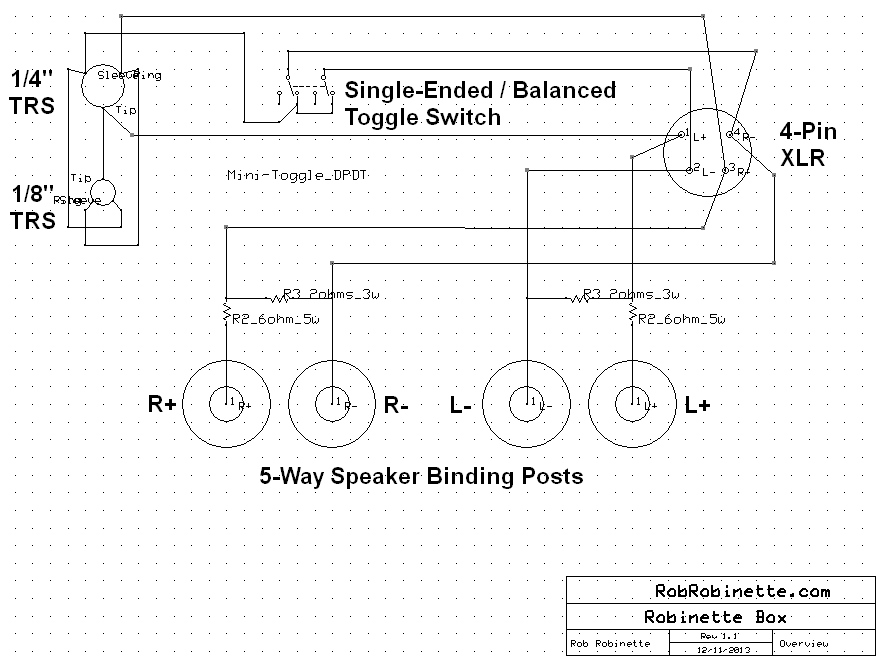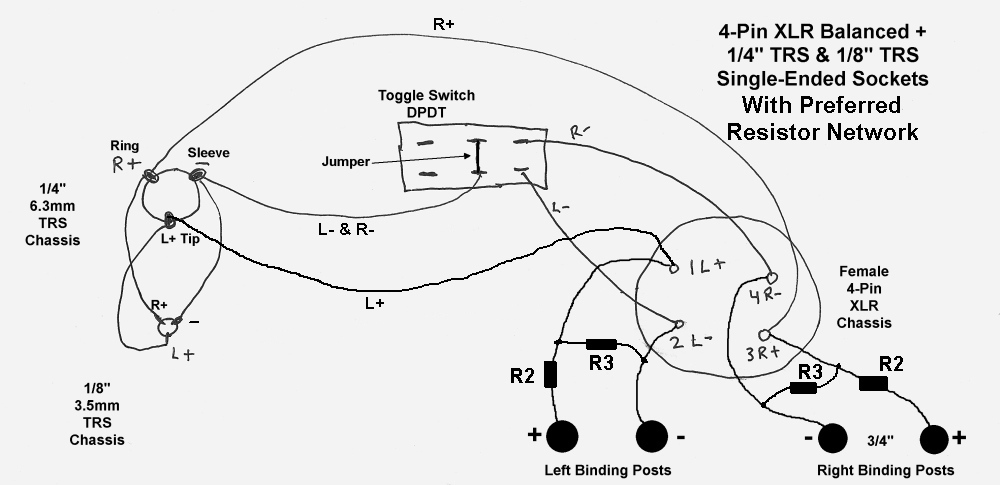Resistor Network Interface With Switched XLR, 1/4" TRS and 1/8" TRS
The "Robinette Box" is a headphone to speaker amplifier interface box. It's designed to electronically match your headphones to a speaker amplifier's speaker output. Four resistors are used to give your amplifier its expected speaker load and to add attenuation to lower the amp's noise floor hiss and increase the useable volume knob movement.
The box features 1/4" (6.3mm) and 1/8" (3.5mm) Female TRS jacks for single-ended headphones and a Female 4-Pin XLR jack for balanced headphones. A toggle switch is used to switch between single-ended amplifiers and amplifiers with balanced output.
Robinette Box Schematic
 Toggle switch is shown in the "Single-Ended Amplifier" position with all three headphone jacks useable. With the switch in the other position, "Balanced Amplifier," only the 4-Pin XLR jack is useable. Download the Robinette Box ExpressSCH schematic file here.
Toggle switch is shown in the "Single-Ended Amplifier" position with all three headphone jacks useable. With the switch in the other position, "Balanced Amplifier," only the 4-Pin XLR jack is useable. Download the Robinette Box ExpressSCH schematic file here.
Robinette Box Detail
Toggle switch toward XLR jack = balanced operation and only XLR jack is useable. Switch toward TRS jacks = single-ended operation with all three jacks useable. Note how the R- and L- are combined at the toggle switch with a jumper between the switch's center terminals.
WARNING: Only select TRS single-ended when connected to an amplifier that has its black speaker terminals tied together.
You can verify this by using a multimeter's continuity function. With the amp unplugged ouch the multimeter's probes to the black speaker terminals. If you get the continuity beep your black speaker terminals are tied together and it's safe to use the TRS single-ended switch position.
Connection Detail
Left + Binding Post.....R2....R3....XLR Pin1....TRS-Tip (either one)....Other TRS-Tip
Left - Binding Post.....R3....XLR Pin2....Switch Terminal1b---Switch Terminal2b....TRS-Sleeve (either)....TRS-Sleeve
Right - Binding Post....R3....XLR Pin4....Switch Terminal1a---Switch Terminal2a....Jumper to Terminal 2b to join Left -
Right + Binding Post....R2....R3....XLR Pin3....TRS-Ring (either)....TRS-Ring
This interface will connect just about any headphone with any amp (tube, solid state, balanced, single-ended). You can
use the XLR and both TRS jacks simultaneously if connected to an amp with common ground output but they're wired in parallel so the circuit impedance will drop. The formula to determine what it drops to is:
2 Headphones Used Simultaneously
With two 32 ohm headphones total impedance = 16 ohms
3 Headphones Used Simultaneously
With three 32 ohm headphones total impedance = 10.7 ohms
Most likely the impedance drop will not have an appreciable effect on the amp or sound quality.
All of this will fit in a 4" x 5" x 1.5" project box. Put four 5-way speaker binding posts on one long side of the box (use 3/4" spacing for dual-banana plug compatibility). Red binding posts are +, black are -. Put the Female 4-Pin XLR chassis connector, 1/4" and 1/8" TRS chassis headphone jacks and DPDT (dual pole, dual throw) toggle switch on the other long side of the box. The R2 resistors should be long enough to make the connection from the + binding posts to the XLR connector without having to use additional wire. 18 to 22 gauge wire is recommended for the internal wiring. I made a set of 3 feet long speaker patch cables using 14 gauge speaker wire and banana plugs to connect the amp to the interface box but 16 or 18 gauge wire would work too.
Parts List
Project Box 4" x 5" x 1.5" or larger
Four 5-way Speaker Binding Posts
18 to 22 gauge wire
Vishay/Dale wirewound non-conductive resistors.
2 each Resistor2
Mouser part# 71-RS0056R000FB12 Vishay part# RS0056R000FB12
5watts 6ohms 1%
2 each Resistor3
Mouser part# 71-NS2B-2 Vishay part# NS02B2R000FB12
3watts 2ohms 1%
Female 4-Pin XLR Chassis Connector
Mini Toggle Switch DPDT (Dual Pole, Dual Throw)
1/4" 6.3mm Stereo TRS Chassis Connector (female, non-grounding)
1/8" 3.5mm Stereo TRS Chassis Connector (female, non-grounding)
I named this the "Robinette Box" after my ex-wife
Rob






























